What is the stagger screen in basketball
The stagger screen in basketball consists of action that occurs when an offensive player cuts from one area of the court to another area via consecutive double screens that are set by two additional offensive players, ultimately to get open for a potential scoring opportunity.
The stagger screen is also a type of basketball screen, particularly an off-ball screen, that could be implemented within a wide variety of basketball offense strategies.
What is a basic example of a stagger screen
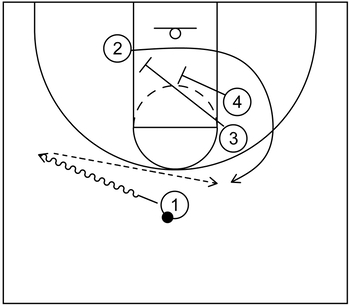
This is a very basic diagram example of a stagger screen, which consists of four offensive players denoted as 1, 2, 3, and 4.
For the general purpose of the diagram, 1, 2, and 3 are perimeter players while 4 is a post player.
In terms of standard basketball positions, 1 would be the point guard, 2 would be the shooting guard, 3 would be the small forward, and 4 would be the power forward.
Another common basketball position that is not shown on the current diagram would be the center, represented as the number 5.
To begin the action, 1 dribbles toward the left side wing area, represented by the arrow with wavy lines.
Next, 2 cuts across the lane to the right slot area behind the three-point line by way of the stagger screen set by 3 and 4.
From there, 2 receives the ball from 1, shown via the dashed arrow, and afterwards, 2 has an opportunity to take the open jump shot.
Why is the stagger screen potentially effective
The stagger screen is potentially effective because it could lead to multiple scoring or playmaking opportunities.
As an example, the stagger screen is commonly used to create an open jump shot near the perimeter, particularly from three-point range for the team’s best shooter.
However, the offensive cutter that would initially try to get open for a jump shot could also reject the screen and cut to the basket.
This particular option could happen if the defender that is guarding the offensive cutter attempts to jam that same cutter by standing in the space between them and the screeners, especially if the stagger screen is in the form of a down screen.
Furthermore, the offensive cutter could possibly execute a curl cut towards the basket, particularly when the defender guarding them trails behind and one of the screener’s defender executes a defensive switch to take away the potential open jump shot near the perimeter.
Moreover, in certain instances, the offensive cutter that utilizes the stagger screen could receive the ball but instead of shooting it, that same player could dribble drive towards the basket, especially if the defender guarding them has to fight through the screen, which could result in a late defensive closeout.
That dribble penetration could then lead to a scoring option at the rim or a playmaking/scoring option beyond the three-point arc by way of basketball passing actions such as the kick pass or drift pass.
Also, one of the screeners involved in the stagger screen action could slip to the basket while the other screener pops to the perimeter. This, in turn, could result in more scoring options near the rim or near the perimeter as well.
In addition to that, after the stagger action, one of the screeners could set an on-ball screen for the player that received the ball or one of the screeners could set an off-ball screen for the other screener, which would be screen the screener action.
The stagger screen could also be implemented as false action and misdirection to primarily occupy the defense on one side of the court while the true offensive action occurs on the other side.
It should also be noted that if a perimeter player would be executing the stagger screen alongside a post player, then the post player should typically be the second screener.
The main reason for this is because it would be generally more difficult for the defensive team if they perform a switch after the second screen, especially if the screen cutter is a perimeter player as well.
For example, if the defender of the second screener is a post player and that same defender switches after the second screen occurs, then it would result in a defensive mismatch.
That is to say, an offensive perimeter player would be guarded by a post defender and at the same time, the offensive post player that set the second screen would be covered by a smaller defender as well.
Affiliate Disclosure: I may earn a commission on qualifying purchases made through the links below.
What are examples of basketball plays that use the stagger screen
Example 1
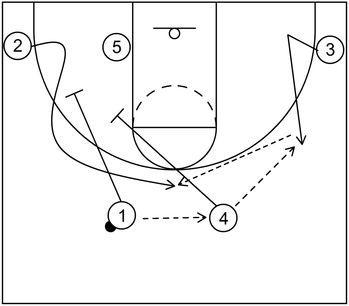
This is an example of a basketball play with very basic action that utilizes the stagger screen to create an open jump shot for the team’s best shooter.
To start, 4 receives the ball from 1 and then 3 gets open with a v-cut to receive the ball from 4. Next, 2 cuts to the top via the stagger screen set by 1 and 4. Afterwards, 2 receives the ball from 3 and takes the open three-point jump shot.
Example 2
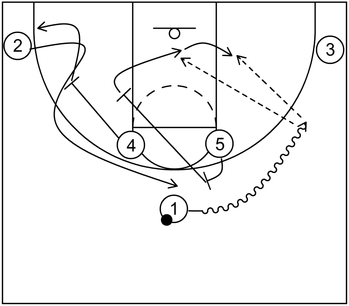
This is an example of a basketball play with very simple action from the Horns offense that uses the stagger screen to get the ball to the team’s best post player.
To begin, 1 dribbles toward the right side wing via the on-ball screen set by 5. Next, 2 cuts to the top via the stagger screen set by 4 and 5.
Immediately after that, 5 slips the screen and cuts to the basket while 4 pops to the left side corner. If 5 is open after the slip action, then 5 could receive the ball from 1 and score near the basket with a layup or dunk.
If 5 is not open, then 5 could cut towards the right side low post block, receive the ball from 1, and score via a low post move.
Example 3
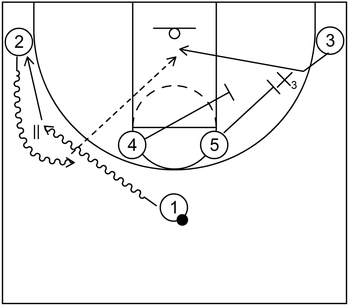
This is another example of a basketball play with basic action from the Horns set. To start, 1 executes a dribble handoff with 2 near the left side wing and afterwards, 1 fills the left side corner.
Following that, 3 would like to cut to the top via a stagger screen set by 4 and 5. However, X3 stands in the gap between 5 and 3 to jam up the cutting pathway.
Therefore, 3 rejects the screen and counters with a backdoor cut to the basket, receives the ball from 2, and scores at the rim.
Example 4
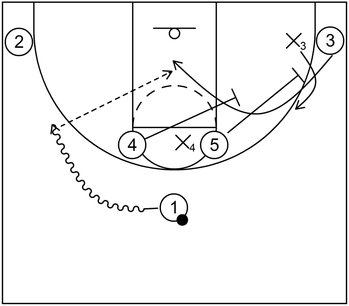
This is yet another example of a basketball play that features simple action from the Horns offense. 1 begins with a dribble entry towards the left side wing.
Next, 3 cuts toward the top as X3 trails behind while fighting through the stagger screen of 4 and 5.
However, X4 lifts up to switch and take away the potential jump shot of 3. Therefore, 3 counters by executing a curl cut towards the basket. From there, 3 receives the ball from 1 and scores at the rim with a layup or dunk.
Example 5 – Part 1
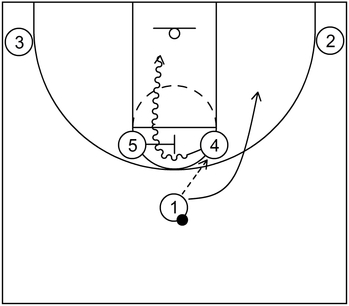
This is an example of a basketball play that features an on-ball screen, dribble handoff action, and the stagger screen to create multiple scoring opportunities.
It is derived from The A-Set Offense by Lason Perkins. To begin, 4 receives the ball from 1 and after that, 1 cuts towards 4 as if to receive a handoff.
However, this is simply false action to confuse the defense. From there, 4 could dribble towards the basket and score at the rim via the on-ball screen set by 5.
Example 5 – Part 2
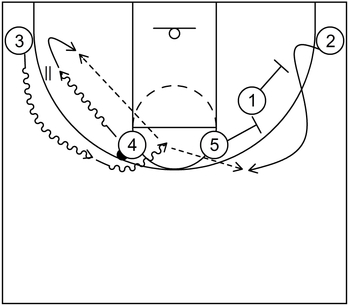
If 4 is not able to drive to the basket after the on-ball screen set by 5, then 4 could execute dribble handoff action with 3. While that occurs, 2 could cut to the perimeter area between the slot and wing via the stagger screen set by 1 and 5.
Next, 3 could take the mid-range jump shot or drive to the basket if that is available. Also, 2 could receive the ball from 3 and take the three-point jump shot if that is open.
Furthermore, 4 could pop to the short corner after the dribble handoff action, receive the ball from 3, and take the mid-range jump shot as well.
Example 6 – Part 1
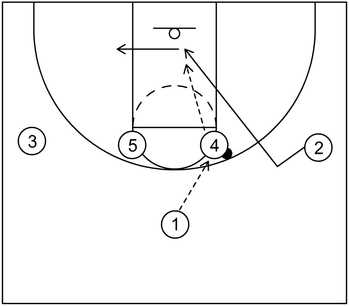
This is an example of a basketball play that is initiated with a 1-4 high formation that includes multiple scoring options.
It is derived from Building the Perfect Offense by Geno Auriemma. To start the action, 4 receives the ball from 1 near the right side high post elbow and this triggers a backdoor cut from 2.
Following that, if 2 is open after executing the cut, then 2 could receive the ball and score at the basket. Otherwise, 2 could continue through to the left side low post block.
Example 6 – Part 2
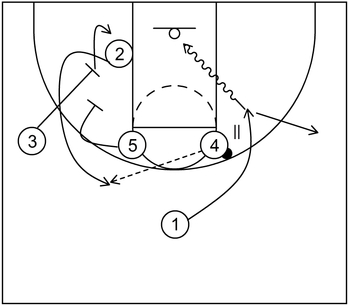
Next, 1 could cut towards the basket, receive a handoff from 4, and score at the rim. However, if 1 does not receive the handoff, then 1 could simply cut out towards the empty right side wing area.
Afterwards, 2 could cut to the left slot area by way of a stagger screen set by 3 and 5. From there, 2 could receive the ball from 4 and take the three-point shot if open.
Also, after setting the screen, 3 could fill the vacant low post area that was previously occupied by 2.
Example 6 – Part 3
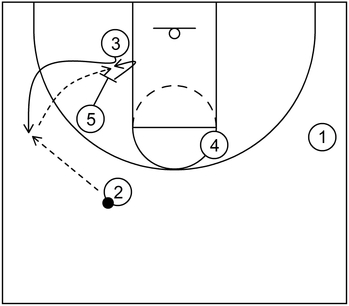
If 2 receives the ball but the three-point shot is not available, then 3 could cut to the left side wing area via the down screen set by 5. From that point, 3 could receive the ball from 2 and take the three-point jump shot if open.
Also, if 3 is not open for the shot, then 5 could post up on the left side block, receive the ball from 3, and score via a low post move.
The post up action could especially be advantageous if the defensive team switches during the stagger screen action, which could result in defensive mismatches, particularly near the low post area.